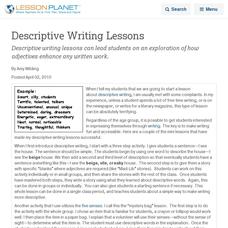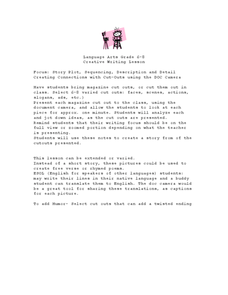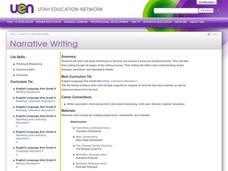Curated OER
Descriptive Writing and Review
This is my type of lesson! Learners read the poem, "The Deserted House" by Mary Coleridge, then complete a series of activities which encourage strong descriptive writing and sensory detail. They'll practice outlining, sentence writing,...
Curated OER
Descriptive Writing: Parrot in the Oven
After reading a selection from Victor Martinez's Parrot in the Oven, pupils use the graphic organizer to decipher the sensory details within the descriptive paragraph. They list various details under the appropriate sense ("see," "hear,"...
K20 LEARN
Sweet and Savory Writing: Descriptive Writing
The engagement is in the details. Young scholars learn the benefit of weaving descriptive and sensory details into the fabric of their writing through the activities in this lesson. As their hands explore items concealed in bags, a...
K20 LEARN
Who Am I? Creating And Editing Descriptive Writing
With descriptive writing, the pleasure is in the details. Young writers learn how to add sensory details to a paragraph about themselves. They read a short paragraph and identify the sensory details used. After revising their draft...
Curated OER
Warm Up with Winter Writing
Try these cool writing lesson ideas that promote creativity and increase vocabulary.
K20 LEARN
Brushstrokes: Communication/Using Descriptive Language
Sometimes a picture reflects a thousand descriptive words. To illustrate the importance of sensory words in descriptive writing, scholars listen to a song and craft a painting in response. After sharing their work with the class,...
Curated OER
Descriptive Writing Lessons
Descriptive writing lessons can lead students on an exploration of how adjectives enhance any written work.
K20 LEARN
Who's Coming To Dinner? Descriptive Writing
"The Dinner Party" is the anchor text in a lesson designed to encourage writers to use sensory details in their stories. After brainstorming descriptive words and phrases for the five senses, class members read Mona Gardner's stark tale...
Curated OER
The Lifesaver Descriptive Writing Lesson
Students observe all of their senses and practice descriptive writing while eating Lifesavers. They write silently about what they are tasting, smelling, and hearing until the candy is dissolved.
Curated OER
Descriptive Writing: Using Art to Inspire description
Write with the senses! Try using art to inspire writers to consider all of the senses. Here, the class is divided in half. Each group looks at one of two images, imagines the senses that would be engaged, and records answers to five...
Curated OER
Descriptive Writing Assessment
First graders explore language arts by undergoing a writing assignment. In this descriptive writing instructional activity, 1st graders identify the skills necessary to write in depth about a subject which they must do based upon a...
Curated OER
Descriptive Writing
Student create descriptive writing pieces through the use of a picture book. In this descriptive writing lesson, students investigate images to emphasize the details in their writing.
Curated OER
Descriptive Writing Using the Book Rumpelstiltskin
Use the fairy tale Rumpelstiltskin to teach your third grade class about descriptive writing. Following a teacher read-aloud of the story, the class brainstorms a list of adjectives describing the main character. Students use this list...
K20 LEARN
Your Best Of/Worst Of Anything: Writing To Engage And Entertain
It was the best of places! It was the worst of places! Middle schoolers practice their descriptive writing skills by creating an e-book about the best of/worst of topics. A series of activities about descriptive writing and worksheets...
Curated OER
Creative Writing Lesson
It's hard to find inspiration; have your learners bring in a slew of magazines and search for inspiring pictures! They look for characters, setting, and possibly even conflict clues. They analyze the pictures they select, turn their...
Curated OER
Writing: Narrative, Expository, Persuasive, and Descriptive
If you are interested in having a basic framework for teaching expository, narrative, persuasive, and descriptive writing, this resource may help; however, you will have to find information on the different forms of writing to share with...
Curated OER
Developing Writing Skills Through Japanese Folk Music
Students listen to Japanese folk songs to get inspired to create a writing piece about Japan. In this writing lesson, students use primary and secondary sources to add information about Japan.
Curated OER
Descriptive Writing-The Hobbit
Young readers write a descriptive paper on the fantasy characters in The Hobbit. They take notes as they read the novel in order to provide descriptions of the character traits of hobbits, dwarfs, trolls, wizards, and goblins. They pay...
Curated OER
Lesson Plan 8: Setting and Mood
What mood does this story evoke? How are setting and mood linked? Young novelists explore the different emotions brought about by writing, starting by journaling things that inspire their own feelings. Examine the word mood, looking into...
Curated OER
Rediscovering the Lost Art of Letter Writing
Writers engage with both past and present experiences to compose a letter during Write to a Friend Month.
Curated OER
Fortune Cookies Motivate Writing
Fortune cookies are used as motivation for a story. In this creative writing lesson, young writers review the six traits process. They discuss interesting characters, setting, problem and solution in a story. Original stories based on...
Scholastic
Quick as a Cricket Lesson Plan
Teaching young learners about similes is easy as pie with this primary grade language arts activity. Following a class reading of the children's book, Quick as a Cricket by Audrey Wood, young readers learn the definition of a simile as...
Curated OER
Descriptive Writing Using Landscape Scenes
Students use the descriptive writing process through the use of landscape scenes, the Paragraph Writing Strategy from the University of Kansas Institute for Research in Learning, and the 4MAT Instructional Model.
Curated OER
Narrative Writing
Binoculars are used as a metaphor for good descriptive writing. Class members first view a small picture and then an enlarged view of the same image in which the details come into focus. Next, learners examine a paragraph lacking sensory...

























